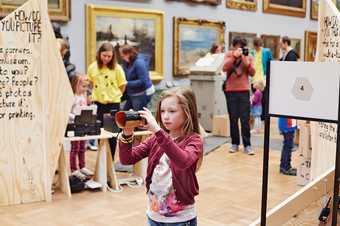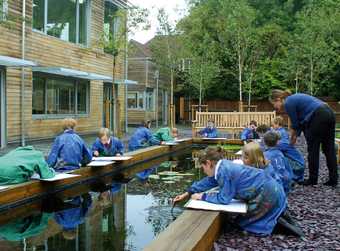
A school group at the We Forgot the Lot! workshop, Tate Britain 2014
Photography by Susie Brady
Art is a break for my mind. In all of the confusion of life I can find peace through it. I can experience my thoughts and feelings in a physical form.
So says one of my twelve year olds. But the case for art is not often made on her terms. Instead, to persuade policy makers of the value of art, we talk about money. The creative industries contribute £77bn, five per cent of our economy, we cry. Or we paint a picture of children’s productivity. Those who study an arts subject get better grades. Or we argue for social mobility – students from low-income families who take part in the arts are three times more likely to get a degree. Or we talk of democracy – arts students are 20 per cent more likely to vote. Or of community – they are twice as likely to volunteer.
All these arguments are strong and true. But they have little to do with children. We debate whether STEM (science, technology and maths) is the key to our country’s future and say that STEM should include the arts and become STEAM: that the nation’s wealth depends on integrating creativity and technology.
Meanwhile, outside my office a small child twirls around while circling a tree. ‘What are you doing?’ I call to him. ‘I am orbiting,’ he calls back, as if it comes as natural as the leaves to the tree. And why should it not?
In the world of the child, science may well be a dance. There is a wisdom in the dancing child who does not know that art and science are different – who uses them equally to express his creativity. We can learn much from him and from all children.
I ask my nine year olds why art is important, and the word that comes back often is ‘freedom’ – freedom to explore ideas and feelings, to make their own marks.
It is important to have the chance to be creative, as it gives you freedom of thought. In art you can go in any direction you like.
When I’m drawing or painting I feel I can escape to the place that I am drawing.
And they cry ‘freedom’ now because the landscape of childhood has changed. We are told that one third of children have never climbed a tree, a quarter have never rolled down a hill, a third have no idea how to build a den, and almost half have never made a daisy chain. The NSPCC, in 1999, reported that 80 per cent of parents wouldn’t let their child play unsupervised in the park. I guess that figure is even greater now. The distance children are allowed to stray from home is, apparently, 1/9th what it was in 1970. In 1971 the average seven year old was making trips to see friends or to the shops on her own. By 1990 that freedom was being withheld until the age of 10; in just 19 years children lost three years of freedom. They will have lost more since.
More than ever, we need to create a space for our children to explore themselves and their world, a safe space to take risks and face challenges, a space for their imagination.
I love making sculpture as anything is possible, and as you work it opens up ideas in your head.
Our children relish their power to make and shape and re-imagine their world. But we have shrunk the horizons of childhood and made the most shut-in generation ever. And shut into their homes and their bedrooms, they are often left free to roam through killing fields in video games or amble into brothels on the internet. We are told that every two days the internet fills with as much new information as was created between the dawn of time and 2003. Children are bombarded with knowledge. A nine year old tells me of his heartfelt worries about war, deforestation and global warming. I had no such fears as a child. More than ever they need time to digest themselves and their world, to see things as they are and dream of how they should be.
One tenth of all the photos ever taken were taken last year, and the internet bulges with them. Images flow at our children like never before. They need to learn to read and interrogate the visual world, to find space to see feelingly and with wonder, to connect and reflect.

Pupils from St John's College School, Cambridge painting the water lilies in the Quiet Garden
Courtesy St John's College School, Cambridge
Almost half of all 14 and 15 year olds say they are addicted to the internet. The epidemic rise of attention deficit hyperactivity disorder (ADHD) tells us of a world too full of sensory noise. Children need time to find rest, to find silence. As my twelve year old says of art:
In all of the confusion of life I can find peace through it. I can experience my thoughts and feelings in a physical form.
Look at my pupils painting water lillies for their ‘Monet: Inspiration from Nature’ project and you will see a tranquillity they need. ‘Feelings’ is another word that comes back again and again when my nine year olds talk about art.
I can let out my feelings in art, particularly if I am feeling angry.
If I’m angry, I go and find my sketchbook and I draw or paint, often with dark colours, and it calms me down. My mind focuses on what I am doing and I can block out any worries, and then everything feels a bit better.
Mostly, they speak of big feelings, of feelings that threaten to get out of control when the world of childhood threatens to become too much.
We are facing a rise of up to 30 per cent a year in the numbers of children and young people seeking treatment for mental health problems. One in 10 five to 16 year olds now has a clinically diagnosed mental disorder. In just the past year, the number of 10 to 14 year olds treated by the nhs for self-harm rose by 30 per cent. It is as though a tsunami of anxiety is flooding the shores of childhood.
In an education system that defines who we are by what grades we get, children now feel under more pressure to perform than ever before. They are more anxious about anticipated or perceived failures. They develop very critical inner voices. Assaulted by images of perfection, false wants and fashions, snapchatting their way through virtual relationships with friends known and not so known, or glued to their Game Boys, it is easy for them to lose touch with themselves, to become unsure of who they are and what they are meant to be, to be overwhelmed.

Schoolchildren with Gerhard Richter's Two Sculptures for a Room by Palermo 1971 at Tate Modern, 2014
Photograph by Lucy Dawkins © Tate
When the world of childhood threatens to overwhelm, the arts help children to discover and organise their feelings safely, to express them and have some mastery over them. When they paint, they give shape and form to their big feelings, rather than being inundated by them. In their own words, my children talk of art as a form of containment, of connection, of healing. Our children still arrive at school as they always did, trailing clouds of glorious creativity, curiosity and wonder and affection. There will be time enough to talk of their contribution to the economy and productivity and progress. First let us learn from them.
Of the many voices calling for creativity to be at the heart of education, none is as powerful as the voice that comes full of thought and feeling from the beating heart of childhood, telling us what the arts mean to our children’s lives. Let us listen to that voice and be led by the child orbiting the tree, turning his learning into a dance.
